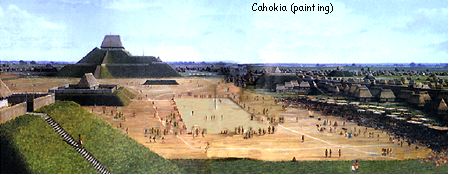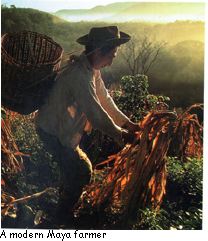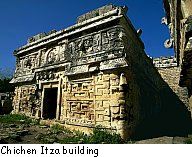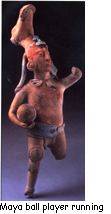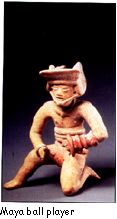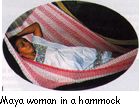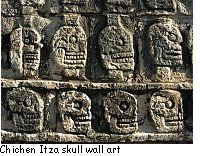Introduction: Very few people know about the prehistoric earth pyramid cultures of the Americas, including the area around Cahokia Mounds in what is now St. Louis, Illinois.
Seven hundred years ago, Cahokia was a thriving center for the vast trade network that criss-crossed North America. Now it’s just a ruin, but 700 years ago it probably looked something like this painting and was home to about 20,000 residents. Some scholars believe that Cahokia was connected to the great civilizations to the west and to the south. This paper is mostly about the civilizations in Central and South America, but it should be pointed out to students that pyramid cultures were also abundant in North America. Later supplements will cover the civilizations of the southwest including Mesa Verde. See the Ancient Trade map.
Pyramid Cultures of Ancient Central and South AmericaAgriculturists led the way to stability, cities and science
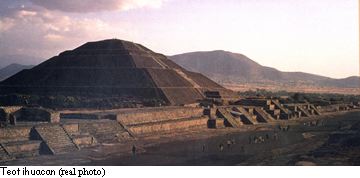
The ancient civilizations of the Americas were far ahead of the rest of the world when it came to farming. Because of their knowledge and skill in planting, hybridizing, irrigating and caring for food crops, they were able to develop cities long before Europeans did. Although most students learn more about Egypt, Greece and Rome than they do about Native America, if you travel to the ancient metropolis of Teotihuacan (or Chichen Itza, Uxmal, Tumal, or hundreds of others) in Mexico, Guatamala and Belize; or to ancient places in South America like Machu Pichu in Peru, you may be amazed that so little attention is given to these wonders in most school books.
Agricultural advancements allowed groups of people to stay in one place with a constant supply of food. Advancements in protecting seed by means of waterproof baskets and pots also added to the security of traveling traders and city dwellers as well, and one of the outcomes of this security was that large populations of robust, healthy people worked together, and created cities like Teotihuacan.
About 5,500 years ago, people got very serious about cultivating corn in Mexico. Nobody knows how long people had already been growing corn on a smaller scale there, but by the year 3,500 B.C., the people had already developed major agricultural technology in Central America, especially Mexico. This is a picture of a modern Mayan farmer who continues to use these skills.
However, cultivated corn was not the only thing that these folks lived on; and farming was not the only thing they did. They also hunted, fished, traded and gathered foods from the wild.
By 2000 B.C. (about 5000 years ago), the native people of Central America were also cultivating squash and beans which supply protein and other nourishing vegetable elements to their diets, as well as avocados which are an excellent source of fat and oil, and chilis (peppers) which are full of vitamins. They soaked their corn in lime water which added calcium to people’s diets, and they thrived on that famous combination of corn and beans which, when eaten together, provide yet another protein, lysine. Think about tacos!
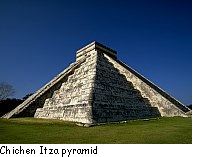
What did they do with all this health and energy? They were a society of poets, artists, athletes, architects and scientists. People in Central America created the famous stepped pyramids like those you can see at Chichen Itza and Tikal. They built spectacular cities, some of which were centers for scientific learning, and astronomical observatories. Mayan paleo-astronomers calculated the cycles of Venus so accurately that it has only been during the last 50 years that computers have matched their accuracy. (Paleo-astronomy is ancient astronomy.)
They took time for sports too. Scholars tell us that the Mayans invented the first organized team sport. They invented the rubber ball, as well as the original ‘ball and goal’ team game similar to lacrosse, shinney, and other soccer/football/ basketball type games.
The players wore elaborate helmets and protective padding. The game was played on special courts, and spectators watched from the sides. The goal was to knock the ball through a hoop built into the side of the playing court.
Native people from Central America also invented the hammock. Many traditional Mayan people still use hammocks in their homes instead of European style beds.
Very far away, in South America, an entirely different group of Quechua people in Peru, whom the Spaniards mistakenly called Inca, developed medical procedures like successful cranial surgery called trepanning. They invented surgical tools made of crystal, gold and bronze. They also developed the silver crowns used in dental work and some cures for diseases. They used anesthetic made from the coca plant, from which modern novocain is derived.
How cultures misperceive each other.
Ancient people in Central America had written languages and mathmetics. Most of the ancient Mexican Mayan books (called codices - one book is called a codex) were burned in the 1500s by superstitious Spanish missionaries who thought Mayan science to be “of the Devil”. However, some Mayan codices still exist. Modern day Mayan scientists and archaeologists are happy to share their knowledge with visitors to the amazing ancient pyramid cities. Their findings are very different from tourist brochures based in Spanish colonial superstitions. For instance, Mayan artists created sculptures depicting a Jaguar with a Serpent coming out of its mouth. The Spaniards thought it looked like a monster vomiting snakes and believed that the books and art of the Mayans were “of the Devil” and needed to be destroyed.
Mayans, on the other hand, intended something sacred. Mayan scholars themselves tell us that the Jaguar represents the sacred eternal creative power of the Creator: the huge skies, the vast oceans, the wild hurricanes, the precious summer rains; that is, Nature. The Serpent represents Knowledge, understanding, wisdom, eternity, life after death. Like a modern cartoon that represents a character “talking” with the words enclosed in a “balloon” over the character’s head, Mayan people showed someone speaking by showing a representation of his thoughts proceeding out of his mouth. When the ancient Mayan Itzas (holy scholars) created sculptures of Knowledge proceeding from the mouth of Nature, they were honoring Science. The ancient Mayans were telling us that Knowledge of Nature gives us Science.
When they carved representations of skulls on the stone walls of Chichen Itza, they were honoring the scientists who lived and worked in that pyramid city as astronomers, engineers, architects, herbalists, agriculturists and doctors. The stone skulls were not meant to be scarey; they were something like the carved sculptures of the busts and heads of Galileo and Copernicus that decorate today’s universities. Cultural misunderstanding goes both ways.
Some Native people of the Americas were horrified when they saw a Spanish crucifix, which depicted a man being crucified. They were even more horrified when they saw Europeans taking Holy Communion: “eating the flesh and drinking the blood” of their Savior. Now, of course, both European and Native American people understand each other better.
Many people ask the question: why did the Mayans vanish? They didn’t vanish at all, although they did abandon the metropolis style of living for the more manageable village style, probably after long seasons of drought and crop failure. Scholars used to say that this represented failure of Mayan societies; but some scholars now feel that it actually represents success in terms of adaptability and survival beyond natural climate changes.
Today over six million Mayan people live in Southern Mexico, Central America and the United States. Many have college degrees in Mayan archaeology, and they are adding to our collective knowledge today, doubley armed with agile memories (oral tradition) and college learning. Most of these people speak at least two languages: a European language and one of the remaining 24 Mayan languages.
Internet Resources:
The US Mint Museum in Charlotte, North Carolina has an exhibit about the Meso-American Ball Game. To learn more about the first team sport in human history, go to www.ballgame.org and listen and watch the Shockwave-Flash multimedia presentation. You can download the free plug-in, and also the various presentations, but it takes awhile so be patient.
You will be able to learn about the ball game, play a computer version of the game, and also learn about some of the various pyramid cultures of Central America. If you click on Explore Meso-America, there is an interactive timeline and map which covers from 1500 BC to 1519 AD when the Spanish conquest began.| Main Menu | Curriculum & Supplements | Cradleboard Private Area | Store |
©2002 Nihewan Foundation
